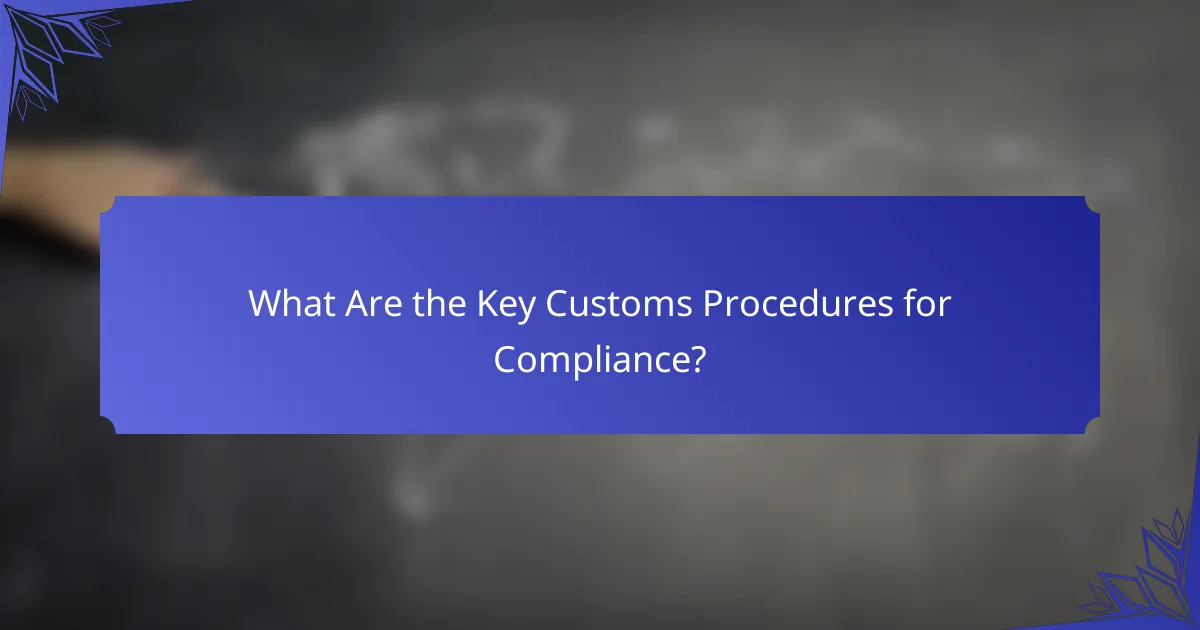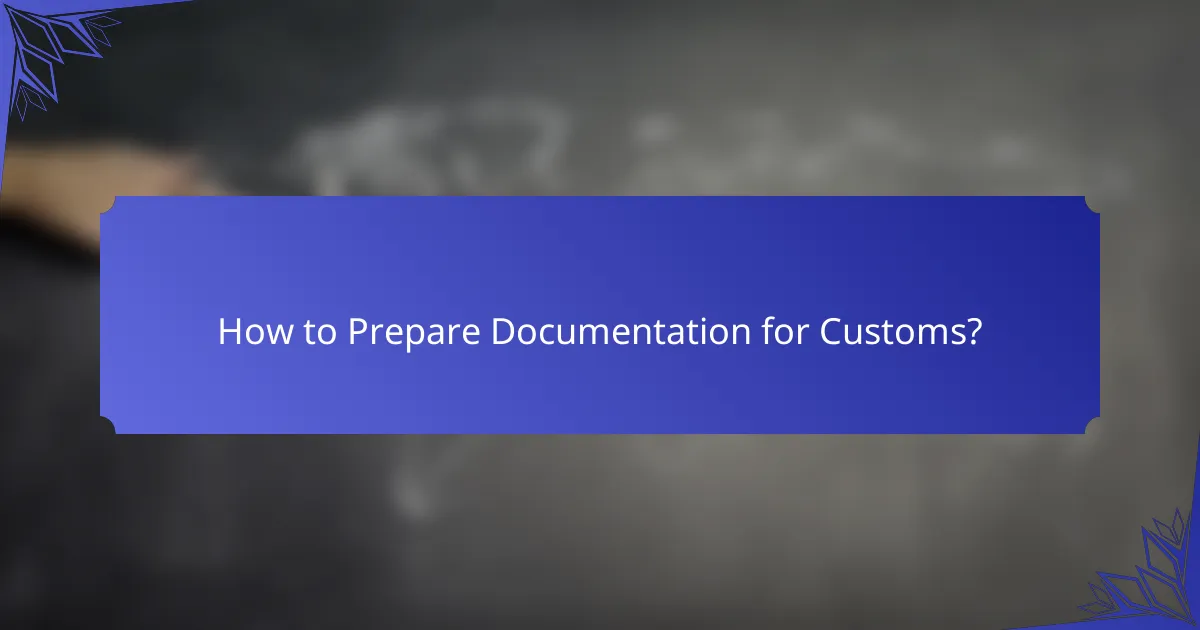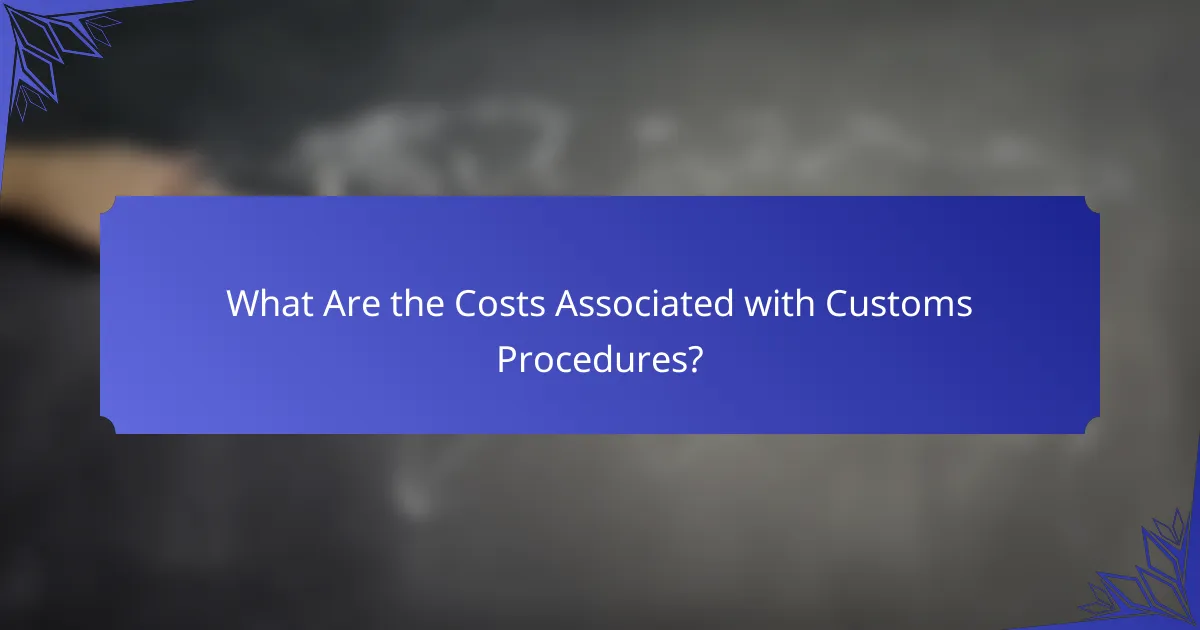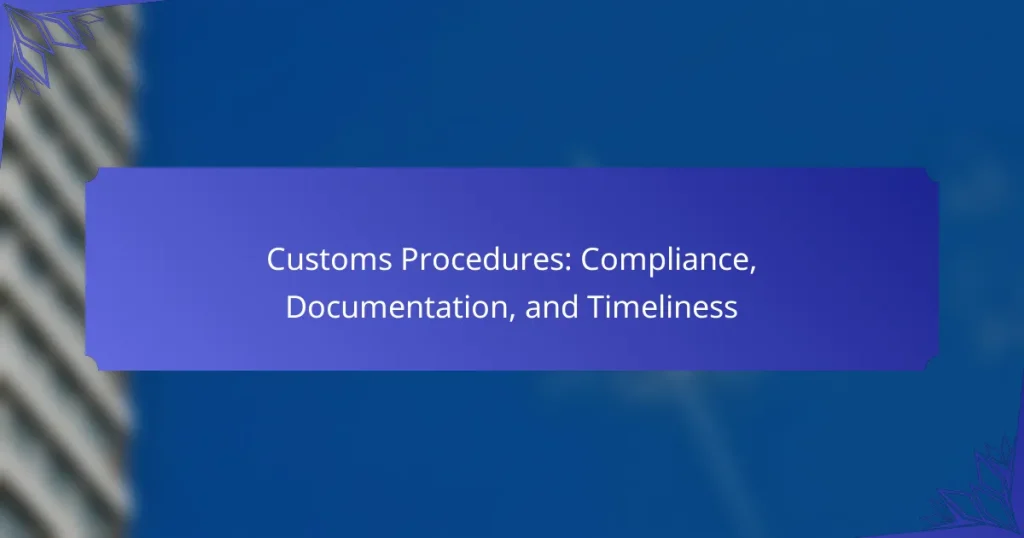Understanding customs procedures is crucial for ensuring compliance, proper documentation, and timely clearance of goods across borders. Key elements include accurate customs declarations, appropriate tariff classifications, and the preparation of essential documents such as commercial invoices and import permits. Timeliness in customs clearance can vary significantly based on factors like the type of goods and the efficiency of customs authorities, making it vital for businesses to stay informed and organized.

What Are the Key Customs Procedures for Compliance?
Key customs procedures for compliance include understanding import and export regulations, completing customs declarations accurately, classifying tariffs correctly, undergoing compliance audits, and implementing risk management strategies. These steps ensure that goods move smoothly across borders while adhering to legal requirements.
Import and export regulations
Import and export regulations dictate how goods can be brought into or sent out of a country. These rules vary by country and can include restrictions on certain items, licensing requirements, and quotas. Familiarizing yourself with the specific regulations of both the exporting and importing countries is essential to avoid delays or fines.
For example, the European Union has strict regulations on food imports, requiring health certifications and inspections. Businesses should regularly check for updates to these regulations to remain compliant.
Customs declarations
Customs declarations are formal documents submitted to customs authorities detailing the nature, value, and origin of goods being imported or exported. Accurate declarations are crucial as they determine the duties and taxes owed and help prevent legal issues. Missing or incorrect information can lead to fines or confiscation of goods.
To ensure accuracy, businesses should maintain detailed records of transactions and consult customs brokers when necessary. Using automated systems can also streamline the declaration process.
Tariff classifications
Tariff classifications categorize goods based on their type and use, which affects the applicable duties and taxes. Each item must be classified correctly according to the Harmonized System (HS) codes. Misclassification can result in overpayment of duties or penalties.
To avoid errors, businesses should invest time in understanding HS codes relevant to their products and consider consulting with customs experts for complex items.
Compliance audits
Compliance audits are assessments conducted to ensure that a business adheres to customs regulations and internal policies. These audits can be initiated by customs authorities or conducted internally to identify potential issues before they escalate. Regular audits help maintain compliance and can improve operational efficiency.
Companies should establish a routine audit schedule and create checklists to cover all necessary areas, including documentation, classification, and declaration accuracy.
Risk management strategies
Risk management strategies in customs compliance involve identifying potential risks and implementing measures to mitigate them. This can include training staff, investing in compliance technology, and developing contingency plans for potential customs issues. A proactive approach minimizes the likelihood of delays and penalties.
Businesses should regularly review their risk management practices and adapt them based on changes in regulations or operational challenges. Keeping abreast of industry trends can also enhance risk mitigation efforts.

How to Prepare Documentation for Customs?
Preparing documentation for customs is essential for ensuring compliance and avoiding delays. Key documents include commercial invoices, bills of lading, certificates of origin, import permits, and export licenses, each serving a specific purpose in the customs process.
Commercial invoices
A commercial invoice is a critical document that outlines the details of a transaction between a buyer and a seller. It typically includes information such as the description of goods, quantity, price, and terms of sale. Ensure that the invoice is accurate and matches the goods being shipped to avoid customs issues.
When preparing a commercial invoice, consider including the Harmonized System (HS) codes for the products, as this can facilitate smoother customs clearance. Always keep a copy for your records and provide a signed original to customs authorities.
Bill of lading
The bill of lading serves as a contract between the shipper and the carrier, detailing the transportation of goods. It acts as a receipt for the cargo and includes essential information such as the names of the shipper and consignee, the destination, and the type of goods being transported.
Make sure the bill of lading is correctly filled out and matches the commercial invoice. There are different types of bills of lading, such as straight and negotiable; choose the one that best fits your shipping needs.
Certificates of origin
A certificate of origin verifies the country in which the goods were produced. This document is often required to determine tariff rates and ensure compliance with trade agreements. It is usually issued by a relevant authority or chamber of commerce.
When obtaining a certificate of origin, ensure that it is properly signed and stamped. Some countries have specific requirements regarding this document, so check the regulations applicable to your trade route.
Import permits
Import permits are official documents required to bring certain goods into a country. They are often necessary for regulated items such as pharmaceuticals, food products, and chemicals. Obtaining an import permit typically involves submitting an application to the relevant government agency.
To avoid delays, apply for import permits well in advance of your shipment. Familiarize yourself with the specific requirements and processing times for the country you are importing into, as these can vary significantly.
Export licenses
Export licenses are required for certain goods being shipped out of a country, particularly those that may have security, health, or environmental implications. The licensing process usually involves submitting documentation to a government authority that assesses the nature of the goods.
Before exporting, check if your products require a license and start the application process early. Compliance with export regulations is crucial to prevent penalties or shipment delays, so stay informed about the specific requirements for your goods and destination country.

What Are the Timelines for Customs Clearance?
Customs clearance timelines vary based on several factors, including the type of goods, the country of origin, and the efficiency of the customs authority. Generally, clearance can take anywhere from a few hours to several days, depending on these variables.
Standard clearance times
Standard customs clearance times typically range from one to three business days for most shipments. For express shipments, clearance may occur within hours, while more complex goods, such as pharmaceuticals or electronics, could take longer due to additional inspections. Understanding these timelines helps businesses plan their logistics effectively.
Factors affecting clearance speed
Several factors can influence the speed of customs clearance, including the completeness of documentation, the nature of the goods, and the workload of the customs office. Incomplete paperwork can lead to delays, while high volumes of shipments during peak seasons may slow processing times. Additionally, certain goods may require more extensive checks, impacting overall clearance speed.
Emergency clearance procedures
In urgent situations, customs authorities may offer emergency clearance procedures, which can expedite the process significantly. These procedures often require additional fees and must be justified with valid reasons, such as perishable goods or critical shipments. Businesses should familiarize themselves with the specific requirements and costs associated with emergency clearance in their respective countries to avoid unexpected delays.

What Are the Costs Associated with Customs Procedures?
The costs associated with customs procedures can significantly impact the overall expenses of importing or exporting goods. Key costs include customs duties, brokerage fees, and storage charges, each of which can vary based on the nature of the goods and the specific regulations of the country involved.
Customs duties and taxes
Customs duties and taxes are fees imposed by governments on imported and exported goods. These charges can vary widely depending on the type of product, its value, and the country of origin. For instance, duties may range from a few percent to over 20% of the item’s value, making it crucial to understand the specific rates applicable to your goods.
To calculate the total customs duty, consider the item’s value, the applicable duty rate, and any additional taxes that may apply, such as VAT or sales tax. It’s advisable to consult the customs tariff schedule of the destination country for accurate information.
Brokerage fees
Brokerage fees are charges paid to customs brokers who facilitate the clearance of goods through customs. These fees can vary based on the complexity of the shipment and the broker’s pricing structure, typically ranging from a flat fee to a percentage of the shipment’s value. Engaging a broker can streamline the customs process, but it’s essential to compare fees among different brokers.
When selecting a customs broker, consider their experience with your specific type of goods and their familiarity with the regulations of both the exporting and importing countries. This can help avoid delays and additional costs during the clearance process.
Storage and handling charges
Storage and handling charges are incurred when goods are held at customs facilities or warehouses due to delays in clearance. These charges can accumulate quickly, often on a daily basis, leading to significant costs if not managed properly. It’s advisable to ensure all documentation is complete and accurate to minimize the time goods spend in storage.
To avoid unexpected storage fees, plan for potential delays by allowing extra time for customs clearance and ensuring that all required documents are prepared in advance. Regular communication with your customs broker can also help anticipate any issues that may arise during the process.

How to Choose a Customs Broker?
Choosing a customs broker is crucial for ensuring compliance with regulations and timely processing of shipments. A good broker can help navigate complex documentation and procedures, ultimately saving time and reducing costs.
Experience and expertise
When selecting a customs broker, consider their experience and expertise in your specific industry. Brokers with a strong background in your sector are more likely to understand the nuances of regulations and documentation required for your products.
Look for brokers who have been in the business for several years and have a proven track record of successful customs clearances. They should also be familiar with the customs regulations of the countries you are importing from or exporting to.
Service offerings
Evaluate the range of services offered by potential customs brokers. Some may provide comprehensive services, including freight forwarding, warehousing, and logistics management, while others may focus solely on customs clearance.
Consider what additional services you might need, such as assistance with tariff classification or duty drawback claims. A broker that offers a full suite of services can streamline your supply chain and reduce the need for multiple vendors.


